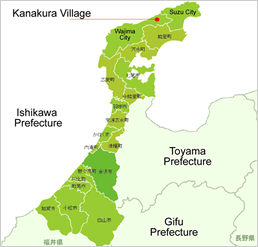
木の音(こえ)» 金蔵万燈会» 金蔵マップ» 歴史年表» 新聞記事» 輪島市のリンク集» 金蔵学校のブログ» English page
お問い合わせ先
- 928-0236
- 石川県輪島市町野町
- 金蔵ソ-121(正楽等方)
- NPO金蔵学校
- TEL: 0768 32-0891
- FAX: 0768 32-8910
- メール
Kanakura Village
The literal translation of the name Kanakura is “treasure store.” Located in basin land along the River Machino, the village is situated between mountainous terrain and the coastal plains of western Machino. Its strategic location proved attractive for local warlords who used it as a place to store riches, hence the name. With these riches came regional wealth, epitomised by the abundance of Buddhist temples built in the area during the Muromachi period (circa 1333-1573). Despite being raised in a series of local battles and invasions, there are still 5 temples in Kanakura, an unusually high number for a single village and a high source of civic pride for its inhabitants. Kanakura’s long and rich history has been recorded in a number of books and often features in local tourist guides.
As shown in the figure below, Kanakura village sits just inside the border between Wajima City and the neighbouring administrative region of Suzu City. Using the Noto toll road, it takes approximately two and half hours to arrive in the prefectural capital of Kanazawa. The nearest airport, Noto Airport, recently constructed in 2005, is approximately a thirty minute journey from the village. The village is surrounded by dense woodland and low mountains, the highest peak being Kanakura Mountain with an altitude of approximately 200m. The area of the village itself is 2 kilometres, over which approximately 50 farmhouses are scattered spatially.

Kanakura School’s activities have multiplied and diversified in recent years leading to a steep rise in member numbers – up to 32 members in 2006. Growing interest and responsibilities prompted Kanakura School to become a nonprofit organisation in 2000. The main activities carried out by the organisation are classified as follows:
- Agricultural initiatives: rice-branding campaign; cultivation and maintenance of the village’s terraced paddy fields; collaboration with local companies to produce rice for sake-making purposes
- Agricultural land conservation: reservoir and farm road management; arable land preservation and environment conservation; use of volunteers for surrounding forest and woodland management
- Living environment improvement: azalea and cherry blossom tree planting scheme; creation and maintenance of landmark and road signs; computer skills class
- Interaction with outside regions: creation of local history map and chronological table; holding events celebrating local history, rice paddy field “owner” system; opening a café inside the Kyougan Temple, which sells dishes made with locally grown agricultural products; maintenance of a rambling route;
Activity/event examples
The NPO’s flagship activity is the “mantoue” (candle-lighting) event held in the village every August. The event embraces the history of the village by commemorating an ancient battle in the village. Single candles are placed in glass cups and positioned in several locations throughout the village, leading up to the grounds of the village temples. The event provides an impressive light show in the evening, supported by other events including traditional dance routines and live music concerts. The event, which has been held annually for the past five years, has risen considerably in stature. It now attracts up to three thousand visitors to the area.